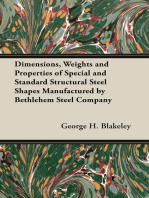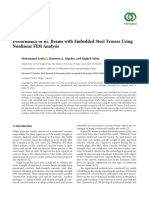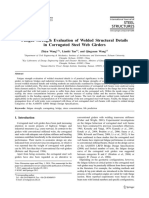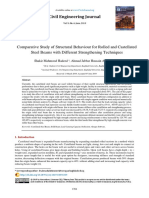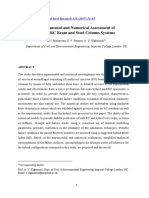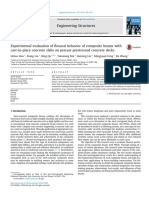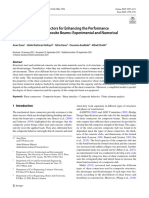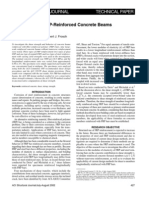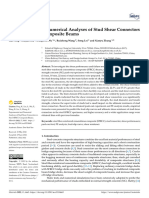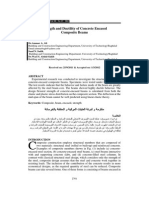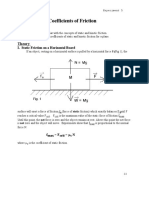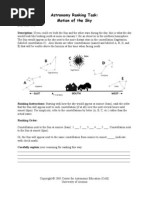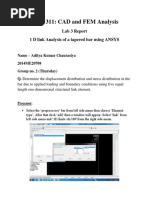ADVSteelConstKOROGLU PDF
ADVSteelConstKOROGLU PDF
Uploaded by
Abdulkadir ÇevikCopyright:
Available Formats
ADVSteelConstKOROGLU PDF
ADVSteelConstKOROGLU PDF
Uploaded by
Abdulkadir ÇevikOriginal Title
Copyright
Available Formats
Share this document
Did you find this document useful?
Is this content inappropriate?
Copyright:
Available Formats
ADVSteelConstKOROGLU PDF
ADVSteelConstKOROGLU PDF
Uploaded by
Abdulkadir ÇevikCopyright:
Available Formats
Advanced Steel Construction Vol. 7, No. 2, pp.
157-172 (2011)
157
GENETIC PROGRAMMING BASED MODELING OF
SHEAR CAPACITY OF COMPOSITE BEAMS WITH
PROFILED STEEL SHEETING
1
2
M. A. Kro lu 1,*, A. Kken 1, M. H. Arslan 1 and A. evik 2
Department of Civil Engineering, Selcuk University, 42075 Konya/TURKEY
Department of Civil Engineering, University Of Gaziantep, 27310/TURKEY
*(Corresponding author: E-mail: makoroglu@selcuk.edu.tr)
Received: 27 July 2010; Revised: 16 September 2010; Accepted: 20 September 2010
ABSTRACT: This study investigates the availability of Genetic Programming (GP) for modeling the ultimate shear
capacity of composite beams with profiled steel sheeting for the first time in literature. Experimental data involving
push-out test specimens of 46 composite beams from an existing database in the literature were used to develop GP
model. The input parameters affecting the shear capacity were selected as stud position (strong and weak), sheeting
type (width of rib of the profiled steel sheeting, depth of the rib), stud dimensions (height and diameter), slab
dimensions (width, depth and height), reinforcement in the slab and concrete compression strength. Moreover, a short
review of well-known building codes regarding ultimate shear capacity of composite beams is presented. The
accuracy of the codes in predicting the ultimate shear capacity of composite beams was also compared with the
proposed GP model with comparable way by using same test data. The study concludes that the proposed GP model
predicts the ultimate shear capacity of composite beams by far more accurate than building codes.
Keywords: Shear connection, composite beams, push-out tests, genetic programming
1.
INTRODUCTION
The composite behavior of two or more structural members joined together by using different
materials is called a composite structure. Each material of a composite structure usually has a
superior property effectively used for providing the composite behavior of the materials. Although
several materials are used as the shear connector of a composite structure, headed stud shear
connectors are generally used in constructions due to their practicality.
In the composite beams with profiled steel sheeting many factors such as; dimensions and direction
of profiled steel sheeting, compressive strength of concrete, reinforcement area and position and
also strength, dimension and location of shear connectors affect the behavior of shear connectors.
Push out tests is commonly used to determine the capacity of the shear connectors and load-slip
behavior of shear connectors. According to Eurocode 4 [1], the push-out specimens consist of a
steel beam section held in the vertical position by two identical concrete slabs. The concrete slabs
are attached to the beam by shear connectors. The connection is subjected to a vertical load, which
produces a shear load along the interface between the concrete slab and the beam flange on both
sides. At a specified load or displacement the slip between the slabs and the beam flange is
evaluated. The failure load divided by the numbers of the connectors is assumed as the shear
connection capacity [2].
Composite construction using steel and concrete has been used since the early 1920s. It gained
widespread use in bridges in the 1950s and in buildings in the 1960s [3]. Both push-out tests, which
were first used in Switzerland in the 1930s [4], and full-scale beam tests have been used to develop
shear stud strength prediction expressions. Push-out tests are usually used to evaluate a wide array
of parameters because of the large size and expense of beam tests.
158
Genetic Programming Based Modeling of Shear Capacity of Composite Beams with Profiled Steel Sheeting
Early shear stud strength prediction equations were for solid slab construction, the equations
developed in the 1960s and 1970s were based on the results of push-out tests. The equations were
modified for the use of steel deck in the late 1970s and were based on full-scale beam tests [5]. The
stud strength equations given by Grant et al [6] were developed from tests mostly using deck
without stiffeners where the studs were welded in the center of the deck rib. Beside the
commonly used headed studs, to obtain optimum solutions for composite action, some
investigations have done with different type of welded shear connectors like, perfobond, T
connector, horseshoe, bar connector etc in the previous studies.
There are many variables affecting the shear capacity of composite beams such as stud position
(strong and weak), sheeting type (width of rib of the profiled steel sheeting, depth of the rib), stud
dimensions (height and diameter), slab dimensions (width, depth and height), reinforcement in the
slab and concrete compression strength. The effect of these variables on the shear capacity of
composite beams has been extensively studied and some empirical approach has been developed
related to variables. For instance, Zellner [7], Veldanda & Hosain [4], Klaiber &Wipe [8] and
Valente & Cruz [9] in the area of composite beams with perfobond ribs. Galjaard and Walraven [10]
performed tests using shear studs, Perfobond connectors, T-connectors and oscillating Perfobond
connectors, both with normal weight and lightweight concrete. Johnson and Oehlers [11] analyzed
125 push-out test results from 11 sources, performed 101 new push-out tests and four composite
T-beam tests, and performed a parametric study. And also Kro lu [12] conducted 4 push-out tests
to study the behavior of Turkish extra seismic reinforcement steel bars as shear connector in
composite beams with profiled steel sheeting perpendicular to beam. In addition, Kro lu also
performed 4 push-out tests with the headed shear connectors as shear connector to compare the
Turkish extra seismic reinforcement steel bars versus headed shear connectors as shear connector
[13, 14]. In Figure 1. test specimen of a composite beam with profiled steel sheeting perpendicular
to beam prepared by Kro lu [12] is given. And also, in Figure 2 the application of the shear
connectors from the existing buildings is shown [15].
Figure 1. A Photo of a Specimen Prepared for the Push-out Tests [12]
M.A. Kro lu, A. Kken, M. H. Arslan and A. evik.
159
Figure 2. Photos from Application of the Shear Connectors from the Existing Buildings [15]
Because of an enormous variety of shear connectors, strength and ductility of shear connectors are
suggested to be determined experimentally. So, because of fast automatic welding procedure
headed stud shear connectors are commonly used to ensure composite action. Since it is certainly
the most investigated and understood form of shear connection, it is probably the most common
form of welded shear connection.
The scope and objectives of the present work are a) to investigate the applicability of Genetic
Programming (GP) in predicting the ultimate shear capacity of composite beams by using
experimental results collected from the literature, b) to discuss the effect of the selected parameters
on to the shear strength. In this sense, experimental data of 46 composite beams with headed stud
shear connectors subjected to push out tests were used from existing databases of Roddenbery [5],
Lloyd & Wright [16], Kim et al [17] and Kro lu [12]. The experimental database is given in Table
Appendix. Furthermore, some code approaches as AISC [18], Eurocode-4 [1], BSI-BS 5950 [19]
and CSA [20] are also examined by comparing their predictions with mentioned experimental
studies results. The results obtained by the proposed ANN model and the codes are compared with
each other.
2.
CALCULATING SHEAR CAPACITY OF COMPOSITE BEAMS
WITH PROFILED STEEL SHEETING
The design strength and stiffness of composite beams with profiled steel sheeting depends on the
shear connection behavior. According to the experimental studies, the main depending factors
defining the strength of shear connectors are:
a) Shape and dimensions of the shear connectors,
b) Quality of its material,
c) Concrete strength,
d) Type of load (static and dynamic),
e) Way of connecting the steel beams,
f) Distance between the shear connectors,
g) Dimensions of the concrete slab (see Figure 3.),
h) Percentage and way of reinforcing
i) Sheeting type and dimension of steel sheeting (see Figure 3.),
In the literature, several formulations have been proposed by various researchers. The review of
these theories is given in Table 1.
160
Genetic Programming Based Modeling of Shear Capacity of Composite Beams with Profiled Steel Sheeting
Figure 3. Test Setup, Dimension of Concrete Slab and Steel Sheeting
Early tests by Fisher [21] were performed and several conclusions were drawn regarding the design
of composite beams with formed metal decks. An equation for stud connector strength is given as
Equation 1. Grant et al [6] was made a modification to the equation developed by Fisher [21]
including the height effect of the stud shear connectors. They provided an empirical equation to
calculate the shear capacity of headed shear studs in composite beams with profiled steel sheeting.
Grants expression for stud connector strength is given as Equation 2. Hawkins and Mitchell [22]
performed a linear regression analysis and developed two separate equations of shear connectors
shear strength due to concrete pull-out failure for 76 mm deck and 38 mm deck. In the Equation 3,
for 76 mm deck and 38 mm deck is 0.35 and 0.61, respectively. (factor dependent upon type of
concrete) is ranging from 0.75 and 1.0 that depends on the density of concrete.
Rambo-Roddenberry [5] carried out 92 push-out tests to study the behavior of headed stud shear
connectors in composite beams with profiled steel sheeting perpendicular to the beam. He provided
also a new strength prediction model, based on the strength prediction equations to calculate the
shear capacity of headed shear studs. In his approaches, the strength prediction divided four parts
which differ from each other to the d/t ratio and stud height.
The design strength and stiffness of composite beams with profiled steel sheeting depends on the
shear connection behavior. Because of the steel deck geometry of the composite beams with
profiled steel sheeting the strength of the shear connectors may be reduced. An empirical
expression for this reduction was developed by evaluating results of composite beam tests in many
standards.
M.A. Kro lu, A. Kken, M. H. Arslan and A. evik.
161
The AISC [18], equation for the calculation of the design strength of headed stud shear connector in
composite beams with profiled steel sheeting perpendicular to the steel beam is given Equation 4.
The r1 (reduction factor), which should not be taken greater than 1.0, is a function of the deck
geometry and the number of studs in a rib. Elastic modulus of concrete is Ec 4700 f c according
to the ACI [23] building code.
In the BSI (BS 5950 Part 3) design strength of headed stud shear
connector in composite beams with profiled steel sheeting perpendicular to the steel beam is
determined by multiplying the values by reduction factor given as Equation 5. In the expression,
h
h
0.2
1 , where r2 is reduction factor (r2 1.0). The
if
3 , must be less than 1.0 for
d
d
design strength for EC4 [1] of the headed stud in composite beams with profiled steel sheeting
perpendicular to the steel beam is similar to the AISC equations, except the constant 0.5 is changed
to 0.29 in the equation, and the upper limit on this strength is 80% of the tensile strength of the stud.
h
h
h
In the expression, if 3
1 and =1 for
4 , is
4 . The strength reduction factor (r3)
d
d
d
is ranging from 1.0 to 0.6. Canadian Standards Association (CSA) [20], specification is the same
equation as the one in the AISC [18] specification. According to the CSA, strength of headed stud
shear connector depends on the depth of the rib given as Equation 7-1 and 7-2.
Table 1. A Review of the Regulations of Shear Capacity of Composite Beams
Model
Fisher [21]
Grant et al.
[6]
Hawkins and
Mitchell [22]
Expression
b0
* 0.5 As
hp
PFISHER
0.36
PGRANT
0.85 b0
N hp
PH &M
Ac
AISC [18]
PAISC
fc
hp
(4.1 n
h
hp
(1)
f cEc
h hp
0.85 b0
N hp
Number
(2)
0.5 As
0.5
0.5 As
f cEc
E
) Ac c
Es
f cEc
0.4
f cu
0 , 35
fu
0.65
(3)
(4)
1.0 )0.5 As
f cEc
As f u
r1
BSI BS 5950
[19]
EC 4 [1]
CSA [20]
PBS 5950
(0.25r2 d 2 0.8 f c Ec , 0.6r2 f u
d2
) min
4
(5)
(6)
PCSA
d2
(0.29r3 d f c Ecm ,0.8r3 f u
) min
4
(4.2 Ac f c , 0.5 As f c Ec As f u )min; for 76 mm deck
(7-1)
PCSA
(7.3 Ac
(7-2)
PEC 4
f c , 0.5 As
f c Ec
As f u )min; for 38 mm deck
162
3.
Genetic Programming Based Modeling of Shear Capacity of Composite Beams with Profiled Steel Sheeting
GENETIC PROGRAMMING
Genetic programming (GP) is an extension to Genetic Algorithms proposed by Koza [24]. Koza
defines GP as a domain-independent problem-solving approach in which computer programs are
evolved to solve, or approximately solve, problems based on the Darwinian principle of
reproduction and survival of the fittest and analogs of naturally occurring genetic operations
such as crossover (sexual recombination) and mutation. GP reproduces computer programs to
solve problems by executing the following steps (Figure 4.) :
1) Generate an initial population of random compositions of the functions and terminals of the
problem (computer programs).
2) Execute each program in the population and assign it a fitness value according to how well
it solves the problem.
3) Create a new population of computer programs.
i) Copy the best existing programs (Reproduction)
ii) Create new computer programs by mutation.
iii) Create new computer programs by crossover (sexual reproduction).
iv) Select an architecture-altering operation from the programs stored so far.
4) The best computer program that appeared in any generation, the best-so-far solution, is
designated as the result of genetic programming [24].
Figure 4. Genetic Programming Flowchart [24]
M.A. Kro lu, A. Kken, M. H. Arslan and A. evik.
163
Gene expression programming (GEP) software which is used in this study is an extension to GP
that evolves computer programs of different sizes and shapes encoded in linear chromosomes of
fixed length. The chromosomes are composed of multiple genes, each gene encoding a smaller
sub-program. Furthermore, the structural and functional organization of the linear chromosomes
allows the unconstrained operation of important genetic operators such as mutation,
transposition, and recombination. One strength of the GEP approach is that the creation of
genetic diversity is extremely simplified as genetic operators work at the chromosome level.
Strength of GEP consists of its unique, multigenic nature which allows the evolution of more
complex programs composed of several sub-programs. As a result GEP surpasses the old GP
system in 100-10.000 times. [25-27].
The phenotype of GEP individuals consists of the same kind of diagram representations
used by GP. However, these complex entities are encoded in simpler, linear structures of fixed
length - the chromosomes. Thus, the main players in GEP are two entities: the chromosomes and
the ramified structures or expression trees (ETs), being the latter the expression of the genetic
information encoded in the former. The process of information decoding (from the chromosomes
to the ETs) is called translation. And this translation implies obviously a kind of code and a set of
rules. The genetic code is very simple: a one-to-one relationship between the symbols of the
chromosome and the functions or terminals they represent. The rules are also very simple: they
determine the spatial organization of the functions and terminals in the ETs and the type of
interaction between sub-ETs in multigenic systems [26,27].
In GEP there are therefore two languages: the language of the genes and the language of ETs
and, in this simple replicator/phenotype system, knowing the sequence or structure of one,
know the other. In nature, although the inference of the sequence of proteins given the sequence
of genes and vice versa is possible, practically nothing is known about the rules that determine
the three-dimensional structure of proteins. But in GEP thanks to the simple rules that
determine the structure of ETs and their interactions, it is possible to infer exactly the
phenotype given the sequence of a gene, and vice versa. This bilingual and unequivocal system
is called Karva language [27].
3.1
Solving a Simple Problem with GEP
For each problem, the type of linking function, as well as the number of genes and the length of
each gene, are a priori chosen for each problem. While attempting to solve a problem, one can
always start by using a single-gene chromosome and then proceed by increasing the length of the
head. If it becomes very large, one can increase the number of genes and obviously choose a
function to link the sub-ETs. One can start with addition for algebraic expressions or for Boolean
expressions, but in some cases another linking function might be more appropriate (like
multiplication or IF, for instance). The idea, of course, is to find a good solution, and GEP provides
the means of finding one very efficiently [25-27].
As an illustrative example consider the following case where the objective is to show how GEP can
be used to model complex realities with high accuracy. So, suppose one is given a sampling of the
numerical values from the curve (remember, however, that in real-world problems the function is
obviously unknown):
y = 3a2 + 2a + 1
(8)
164
Genetic Programming Based Modeling of Shear Capacity of Composite Beams with Profiled Steel Sheeting
over 10 randomly chosen points in the real interval [-10, +10] and the aim is to find a function
fitting those values within a certain error. In this case, a sample of data in the form of 10 pairs (ai, yi)
is given where ai is the value of the independent variable in the given interval and yi is the
respective value of the dependent variable (ai values: -4.2605, -2.0437, -9.8317, -8.6491, 0.7328,
-3.6101, 2.7429, -1.8999, -4.8852, 7.3998; the corresponding yi values can be easily evaluated).
These 10 pairs are the fitness cases (the input) that will be used as the adaptation environment. The
fitness of a particular program will depend on how well it performs in this environment [25-27].
There are five major steps in preparing to use gene expression programming. The first is to choose
the fitness function. For this problem one could measure the fitness fi of an individual program i by
the following expression:
Ct
fi
(M
C(i , j ) T j )
(9)
j 1
where M is the range of selection, C(i,j) the value returned by the individual chromosome i for
fitness case j (out of Ct fitness cases) and Tj is the target value for fitness case j. If, for all j, |C(i,j) Tj| (the precision) less than or equal to 0.01, then the precision is equal to zero, and fi = fmax = Ct*M.
For this problem, use an M = 100 and, therefore, fmax = 1000. The advantage of this kind of fitness
function is that the system can find the optimal solution for itself. However there are other fitness
functions available which can be appropriate for different problem types [25-28].
The second step is choosing the set of terminals T and the set of functions F to create the
chromosomes. In this problem, the terminal set consists obviously of the independent variable, i.e.,
T = {a}. The choice of the appropriate function set is not so obvious, but a good guess can always
be done in order to include all the necessary functions. In this case, to make things simple, use the
four basic arithmetic operators.
Thus, F = {+, - , *, /}. It should be noted that there many other functions that can be used.
The third step is to choose the chromosomal architecture, i.e., the length of the head and the
number of genes.
The fourth major step in preparing to use gene expression programming is to choose the linking
function. In this case we will link the sub-ETs by addition. Other linking functions are also
available such as subtraction, multiplication and division.
And finally, the fifth step is to choose the set of genetic operators that cause variation and their rates.
In this case one can use a combination of all genetic operators (mutation at pm = 0.051; IS and
RIS transposition at rates of 0.1 and three transposons of length 1, 2, and 3; one-point and
two-point recombination at rates of 0.3; gene transposition and gene recombination both at rates of
0.1).
To solve this problem, lets choose an evolutionary time of 50 generations and a small population of
20 individuals in order to simplify the analysis of the evolutionary process and not fill this text with
pages of encoded individuals. However, one of the advantages of GEP is that it is capable of
solving relatively complex problems using small population sizes and, thanks to the compact Karva
notation; it is possible to fully analyze the evolutionary history of a run. A perfect solution can be
found in generation 3 which has the maximum value 1000 of fitness. The sub-ETs codified by each
gene are given in Figure 3. Note that it corresponds exactly to the same test fuction given above in
Equation 8 [25-27].
M.A. Kro lu, A. Kken, M. H. Arslan and A. evik.
165
Thus expressions for each corresponding Sub-ET can be given as follows:
y = ( a2 + a ) + ( a + 1 ) + ( 2a2 ) = 3a2 + 2a + 1
4.
(10)
NUMERICAL APPLICATION
In this study, GeneXproTools 4.0 [29] software package is used for GP modeling of shear capacity
of composite beams with profiled steel sheeting. Among the experimental database, 10 tests were
used as testing set and the remaining 36 test as training set for GP training. The proposed GP
formula is an empirical equation based on the experimental database given in section 2. In the
proposed GP model, input parameters were selected based on previously published studies which
are sheeting type (width of rib of the profiled steel sheeting, depth of the rib), stud dimensions
(height and diameter), slab dimensions (width, depth and height), reinforcement in the slab and
concrete compression strength. The ranges of variables in the experimental database where the
proposed GP model will be valid are given in Table A.1. Related parameters of the GP training are
presented in Table 2. Statistical parameters of the proposed GP model are given in Table 3. The
performance of GP model vs. test results is shown in Figure 5. The entire database with
corresponding experimental and GP results are given in Table A.1. The expression tree of the GP
model is presented in Figure 6 where d0, d1, d2, d3, d4 and d5 correspond to b1, b2, b3, hp, t and d
respectively. Constants shown in Figure 6 are -8715, 7765 and -6405 respectively. After putting the
constants, the final formulation for ultimate shear capacity of composite beams is obtained as
follows:
hp
b2
N
Fu
65.93 h
b3
d
t
d 8.72
A
t
b3
b3 b1
Fu
f cu
b1
(11)
Table 2. Parameters of GP Model
P1
Function Set
+,-,*,/,
P2
Chromosomes
30-200
P3
Head Size:
2-6
P4
Number of Genes:
1-4
P5
Linking Function:
Addition, Multiplication
P6
Fitness Function Error Type:
MAE, RMSE, Custom Function
P7
Mutation Rate:
0,044
P8
Inversion Rate:
0,1
P9
One-Point Recombination Rate: 0,3
P10 Two-Point Recombination Rate: 0,3
P11 Gene Recombination Rate:
0,1
P12 Gene Transposition Rate:
0,1
, ln
166
Genetic Programming Based Modeling of Shear Capacity of Composite Beams with Profiled Steel Sheeting
Table 3. Statistical Parameters of the Proposed GP Model
GP Testing Set
GP Training Set
GP Total Set
Mean
1.06
1.01
1.02
COV
0.125
0.125
0.125
R2
0.86
0.92
0.91
120
2
R = 0.91
100
GP (kN)
80
60
40
20
0
0
20
40
60
80
Ptest (kN)
Figure 5. Performance of Test and GP Results
100
120
M.A. Kro lu, A. Kken, M. H. Arslan and A. evik.
167
Figure 6. Expression Tree for Ultimate Shear Capacity of Composite Beams
The predicted ultimate shear strength values of the GP model are observed to be in very good
agreement with the experimental data. The GP prediction accuracy is also compared with
accuracies of code equations in Table 4. As seen the proposed GP model is by far more accurate
than available design codes.
Table 4. Comparison of Accuracy of GP Model Versus Various Design Codes
GP
Paisc
Pec4
Pbs
Pcsa
Mean
1.02
0.72
0.91
1.20
0.72
COV
0.125
0.17
0.19
0.18
0.17
R2
0.91
0.79
0.78
0.79
0.79
168
Genetic Programming Based Modeling of Shear Capacity of Composite Beams with Profiled Steel Sheeting
The prediction accuracy of various standards of building codes related to torsional strength of the
beams for mentioned tested 46 specimens are presented in Table 4. As seen from Table 4., AISC
1999[18], Eurocode-4[1], BSI. BS 5950 [19] and CSA [20] shear capacity of composite beams
expressions have the most powerful estimating capacity.
Although the estimation rate of design codes is nearly 79%, GP model can estimate the shear
capacity of shear studs in the composite beams with profiled steel sheeting such a high rate (91%)
GP and the other soft computing methods such as ANN, ANFISetc have more advantages than
design codes formulas since they can train themselves in a comfortable way according to available
data easily. Nevertheless, in design codes formulas all parameters that can change the result are not
considered for some reason. Moreover, the maximum strength of materials and regulations are
taken into consideration in the codes approaches. For instance, when calculating the shear capacity,
the steel is assumed as to be yielded or the concrete reached the maximum compressive strength.
While all materials could not run at full capacity during the experiments.
According to the results obtained from this study, GP can estimate the shearing capacity of shear
studs in the composite beams with profiled steel sheeting in a very satisfactory way. But it is
important to be known that the results can be changed by the selected data sets and using
parameters in GP methods.
5.
CONCLUSION
This study is a pioneer work that addresses the feasibility of GP as an alternative approach for the
empirical formulation of shear capacity of shear studs in the composite beams with profiled steel
sheeting for the first time. The proposed GP model is based on a wide range experimental database
collected from the literature. The results of the proposed GP model are seen to be by far more
accurate than current design codes and existing equations available in literature. Most of the design
codes and equations available in literature are based on the regression analysis of predefined
functions. However in the case of GP approach presented in this study, there is no predefined
function to be considered. The GP approach generates various formulations and optimizes the best
one that fits the experimental database best. The outcomes of this study are quite satisfactory which
may serve GP approaches to widely used in further applications in the field of composite structures.
NOTATION
A
Ac
As
B
b0
b1
b2
b3
D
d
Ec
Ecm
e
fc
Area of stud shank
Concrete pull-out failure surface area
The cross-sectional area of the headed stud shear connector
Width of composite concrete slab
Average width of concrete rib of the profiled steel sheeting
Smaller width of rib of the profiled steel sheeting
Larger width of rib of the profiled steel sheeting
Upper section of smaller width of rib of the profiled steel sheeting
Depth of composite concrete slab
Diameter of headed stud shear connector
Initial Youngs modulus of concrete
Mean value of the secant modulus tabulated in the EC4
Distance from the center of the studs longitudinal
Compressive cylinder strength of concrete
M.A. Kro lu, A. Kken, M. H. Arslan and A. evik.
fcu
fu
fys
H
h
hp
N
n
PAISC
PBS 5950
PCSA
PEC4
PFISHER
PGRANT
POOLGAARD
PPOS
PRR
PSOL
r
r1
r2
r3
Vc
t
169
Compressive cube strength of concrete
Minimum specified tensile stress of the stud shear connector
Yield stress of headed stud shear connector
Height of composite concrete slab
Height of the headed stud
Depth of the rib
Number of studs in one rib of the profiles steel sheeting
Number of studs subjected to similar displacements
Design strength calculated using the American Specification
Design strength calculated using British Standard
Design strength calculated using Canadian Standards Association
Design strength calculated using European Code
Design strength calculated using Fisher formula
Design strength calculated using Grant formula in solid slab
Design strength calculated using Oolgaard formula
Concrete pull-out strength of a stud in a composite slab
Design strength calculated using Rambo-Roddenbery formula
Design strength calculated using Fisher formula in solid slab
Reduction factor
Reduction factor
Reduction factor
Reduction factor
Shear strength due to concrete pull-out failure (N)
Factor dependent upon type of concrete
Profiled steel sheeting thickness
ACKNOWLEDGEMENT
This research was supported by Gaziantep University Research project Unit and Selcuk University
BAP Office (SU-BAP 2007/06201071). Some data were taken from the Master of Science Thesis
of M.A. Kro lu named Usage of Earthquake Steel Bar as Shear Connection in Composite Slabs
REFERENCES
[1]
[2]
[3]
[4]
[5]
[6]
Eurocode 4, EN 1994-1-1:2004, Design of Composite Steel and Concrete Structures,
European Committee for Standardisation (CEN), 2004.
Ellobody, E. and Young, B., Performance of Shear Connection in Composite Beams with
Profiled Steel Sheeting, Journal of Constructional Steel Research, 2006, Vol. 62, No. 7, pp.
682-694.
Ollgaard, J.G., Slutter, R.G., and Fisher, J.W., Shear Strength of Stud Connectors in
Lightweight and Normal-Weight Concrete, Engineering Journal, AISC, 1971, Vol. 8, No. 2,
pp. 55-64.
Veldanda, M.R. and Hosain, M.U., Behavior of Perfobond Rib Shear connectors: Push-Out
Tests, Canadian Journal of Civil Engineering, 1992, Vol. 19, No.1, pp. 110.
Rambo-Roddenberry, M.D., Behavior and Strength of Welded Stud Shear Connectors,
PhD Dissertation, Department of Civil Engineering, Virgiana Politechnic Institute and State
University, USA, 2002.
Grant, J.A., Fisher, J.W. and Slutter, R.G., Composite Beams with Formed Steel Deck,
Engineering Journal, AISC, 1977, Vol. 14, No. 1, pp. 24-43.
170
[7]
[8]
[9]
[10]
[11]
[12]
[13]
[14]
[15]
[16]
[17]
[18]
[19]
[20]
[21]
[22]
[23]
[24]
[25]
[26]
[27]
[28]
[29]
Genetic Programming Based Modeling of Shear Capacity of Composite Beams with Profiled Steel Sheeting
Zellner, W., Recent Designs of Composite Bridges and a New Type of Shear Connectors,
Proceedings of the IABSE/ASCE Engineering Foundation Conference on Composite
Construction, Henniker, N.H., pp. 240-252.
Klaiber, F.W. and Wipe, T.J., An Alternate Shear Connector for Composite Action, Proc.
Mid-continent Transportation Symposium 2000, Iowa State University, 2000.
Valente, I. and Cruz, P.J.S., Experimental Analysis of Perfobond Shear Connection
between Steel and Lightweight Concrete, Journal of Constructional Steel Research, 2004,
Vol. 60, No. 3-5, pp. 465-479.
Galjaard, J.C. and Walraven, J.C., Behavior of Shear Connector Devices for Lightweight
Steel-Concrete Composite StructuresResults, Observations and Comparisons of Static
Tests, 2000, pp. 221-230.
Johnson, R.P. and Oehlers, D.J., Analysis and Design for Longitudinal Shear in Composite
T-Beams. Proc. Instn Civ. Engrs, 1981, Part 2, Vol. 71, No. 4, pp. 989-1021.
Kro lu, M.A., Usage of Earthquake Steel Bar as Shear Connection in Composite Slabs,
MSc Thesis, Seluk University, Konya Turkey, 2007 (In Turkish).
Kro lu, M.A. and Kken, A., Load Bearing Capacity of Headed Studs in Composite
Beams 3th National Steel Structures Symposium, 8-10 October, 2009 Gaziantep, Turkey
(In Turkish).
Kken, A. and Kro lu, M.A., An Experimental Study on the Usability of Earthquake
Resistant Steel Bar as a Shear Connector in Composite Slabs, 10th European Conference on
Non-Destructive Testing 2010, 7-11 June, Moscow, Russia.
http://www.corusconstruction.com/en/
Lloyd, R.M. and Wright, H.D., Shear Connection between Composite Slabs and Steel
Beams, Journal of Constructional Steel Research, 1990, Vol. 15, No. 4, pp. 255-285.
Kim, B., Wright, H.D. and Cairns, R., The Behavior of Through-deck Welded Shear
Connectors: An Experimental and Numerical Study, Journal of Constructional Steel
Research, 2001, Vol. 57, No. 12, pp. 1359-1380.
AISC, Load and Resistance Factor Design Specification for Structural Steel Building,
1999, American Institute of Steel Construction, Chicago.
BSI, BS 5950, Part 3: Section 3.1. Code of Practice for Design of Simple and Continuous
Composite Beams, 1990, British Standards Institution, London.
CSA, Steel Structures for Buildings - Limit State Design, 1984, Canadian Standards
Association.
Fisher, J.W., Design of Composite Beams with Formed Metal Deck, Engineering Journal,
AISC, 1970, Vol. 7, No.3, pp. 88-96.
Hawkins, N.M. and Mitchell, D., Seismic Response of Composite Shear Connections,
Journal of Structural Engineering, ASCE, 1984, Vol. 110, No. 9, pp. 2120-2136.
ACI, Building Code Requirements for Structural Concrete and Commentary, 1999,
American Concrete Institute, Detroit.
Koza, J.R., Genetic Programming: On the Programming of Computers by Means of
Natural Selection, Cambridge, MA: MIT Press, 1992.
Ferreira, C., Gene Expression Programming in Problem Solving, 6th Online World
Conference on Soft Computing in Industrial Applications, September 10-24, 2001.
Ferreira, C., Gene Expression Programming: A New Adaptive Algorithm for Solving
Problems, Complex Systems, 2001, Vol. 13, No. 2, pp. 87-129.
Ireland, J.C., Baeten, M., Foster, J., Lutton, E. and Ryan, C., Genetic Programming, 5th
European Conference, 2002, EuroGP.
Cevik, A., Arslan, M.H. and Kroglu, M.A., Genetic-programming-based Modeling of RC
Beam Torsional Strength KSCE Journal of Civil Engineering, 2010, Vol. 14, No. 3, pp.
371-384.
www.gepsoft.com
M.A. Kro lu, A. Kken, M. H. Arslan and A. evik.
APPENDIX
Table A.1. Database with corresponding experimental and GP results
171
172
Genetic Programming Based Modeling of Shear Capacity of Composite Beams with Profiled Steel Sheeting
You might also like
- Lesson Plans - LightDocument9 pagesLesson Plans - Lightjatinder kaur89% (9)
- Simulation of Chlorobenzene Plant by Using Aspen PlusDocument29 pagesSimulation of Chlorobenzene Plant by Using Aspen PlusAshish Mishra100% (3)
- Application Guide For High Voltage Accessories PDFDocument182 pagesApplication Guide For High Voltage Accessories PDFla ammiragfliaNo ratings yet
- Reinforced Concrete Buildings: Behavior and DesignFrom EverandReinforced Concrete Buildings: Behavior and DesignRating: 5 out of 5 stars5/5 (1)
- Dimensions, Weights and Properties of Special and Standard Structural Steel Shapes Manufactured by Bethlehem Steel CompanyFrom EverandDimensions, Weights and Properties of Special and Standard Structural Steel Shapes Manufactured by Bethlehem Steel CompanyNo ratings yet
- Ansys Fluent 12.0 Theory Guide - 7.1Document3 pagesAnsys Fluent 12.0 Theory Guide - 7.1Tg DgNo ratings yet
- Journal of Conustruction Steel ResearchDocument6 pagesJournal of Conustruction Steel ResearchrudrakunduceNo ratings yet
- 10 5923 J Cmaterials 20120203 02Document10 pages10 5923 J Cmaterials 20120203 02ashenafiNo ratings yet
- Performance of RC Beams With Embedded Steel TrusseDocument9 pagesPerformance of RC Beams With Embedded Steel TrussevignamNo ratings yet
- Research ArticleDocument19 pagesResearch ArticleRomanbabu OinamNo ratings yet
- Journal of Constructional Steel Research: E.L. Tan, B. UyDocument10 pagesJournal of Constructional Steel Research: E.L. Tan, B. UyvenkatesanjsNo ratings yet
- Local and Post-Local Buckling of Fabricated High-Strength Steel and Composite Columns, 2019 (Zhichao Huang) PDFDocument15 pagesLocal and Post-Local Buckling of Fabricated High-Strength Steel and Composite Columns, 2019 (Zhichao Huang) PDFPhan Đào Hoàng HiệpNo ratings yet
- Composite Concrete Slabs With Profiled SDocument13 pagesComposite Concrete Slabs With Profiled SramiNo ratings yet
- Fatigue Strength Evaluation of Welded Structural Details in Corrugated Steel Web GirdersDocument15 pagesFatigue Strength Evaluation of Welded Structural Details in Corrugated Steel Web Girdersaminashash95No ratings yet
- Copy First Phase Report MSDocument39 pagesCopy First Phase Report MSSREEKUMARA GANAPATHY V S stellamaryscoe.edu.inNo ratings yet
- Numerical Study of R.C. Beams Strengthening by External Steel PlateDocument9 pagesNumerical Study of R.C. Beams Strengthening by External Steel PlateAJER JOURNALNo ratings yet
- Seismic Behavior of Short Coupling Beams With Different Reinforcement LayoutsDocument10 pagesSeismic Behavior of Short Coupling Beams With Different Reinforcement LayoutsleotramontinNo ratings yet
- 1532 4516 1 PB PDFDocument11 pages1532 4516 1 PB PDFDanu AdiNo ratings yet
- Ref 25Document26 pagesRef 25SHEIK MASTANNo ratings yet
- Seismic Behavior of Steel Beam and Reinforced Concrete Column ConnectionsDocument20 pagesSeismic Behavior of Steel Beam and Reinforced Concrete Column Connectionsjuan carlosNo ratings yet
- Steel Capacity of Headed Studs Loaded in ShearDocument10 pagesSteel Capacity of Headed Studs Loaded in ShearMallesh NenkatNo ratings yet
- s10518-020-00842-yDocument25 pagess10518-020-00842-yKRISHNA MURARINo ratings yet
- 2008 NASCC Paper CJ-Series Final 17jan08Document16 pages2008 NASCC Paper CJ-Series Final 17jan08Demçe FlorjanNo ratings yet
- AulaDocument45 pagesAulajorge mathaeusNo ratings yet
- Experimental Investigation On Shear Capacity of STDocument18 pagesExperimental Investigation On Shear Capacity of STadnan-651358No ratings yet
- Bond Characteristics High-Strength Steel ReinforcementDocument6 pagesBond Characteristics High-Strength Steel ReinforcementUmair BaigNo ratings yet
- Deck Concentrated Loads AcceptedDocument65 pagesDeck Concentrated Loads Acceptedakhilesh120No ratings yet
- Design of Composite Slabs With Profiled Steel Deck PDFDocument16 pagesDesign of Composite Slabs With Profiled Steel Deck PDFsourabh mahanaNo ratings yet
- Investigation of Seismic Behavior of Steel Coupling Beams in Hybrid Coupled StructuresDocument9 pagesInvestigation of Seismic Behavior of Steel Coupling Beams in Hybrid Coupled StructuresSinem Kocabaş ŞirikçiNo ratings yet
- Design of Composite Slabs With Profiled Steel Deck PDFDocument16 pagesDesign of Composite Slabs With Profiled Steel Deck PDFPanha MenhNo ratings yet
- Experimental and Numerical Investigation On Full-Scale Tension-Only CBF Steel Beam Through FramesDocument18 pagesExperimental and Numerical Investigation On Full-Scale Tension-Only CBF Steel Beam Through FramesponjoveNo ratings yet
- Sand 4Document17 pagesSand 4Pavan MNo ratings yet
- A.Farzampour - Seismic Behavior of Corrugated Steel Shear WallsDocument5 pagesA.Farzampour - Seismic Behavior of Corrugated Steel Shear WallsNelson ChinNo ratings yet
- 10.1016@j.jcsr.2020.106243Document12 pages10.1016@j.jcsr.2020.106243Adnan Enam AkidNo ratings yet
- Block Shear 1-S2.0-S0263823121007059-MainDocument19 pagesBlock Shear 1-S2.0-S0263823121007059-MainHamza MehboobNo ratings yet
- Hou 2016Document12 pagesHou 2016Evonne LeeNo ratings yet
- The Use of Shear Connectors For Enhancing The Performance of Steel-Concrete Composite Beams: Experimental and Numerical AssessmentDocument11 pagesThe Use of Shear Connectors For Enhancing The Performance of Steel-Concrete Composite Beams: Experimental and Numerical AssessmentMALIKNo ratings yet
- Flexural properties of new cold-formed thin-walled steel and concreteDocument13 pagesFlexural properties of new cold-formed thin-walled steel and concreteakhilsigninsNo ratings yet
- Liu 2004Document14 pagesLiu 2004SaliNo ratings yet
- 2 CompositeDocument9 pages2 CompositeSurumi Rasia SalimNo ratings yet
- An Analytical Approach To Predict Shear Capacity of Steel Fiber ReinforcedDocument14 pagesAn Analytical Approach To Predict Shear Capacity of Steel Fiber ReinforcedDiego SukNo ratings yet
- 3D Modelling of Shear Connector Behaviour With Partially InteractionDocument7 pages3D Modelling of Shear Connector Behaviour With Partially Interactionsatyakali24No ratings yet
- Effect of Reinforcement StiffenersDocument13 pagesEffect of Reinforcement Stiffenersjust meNo ratings yet
- Experimental and Analytical Study On Fatigue Behavior of Composite Truss JointsDocument17 pagesExperimental and Analytical Study On Fatigue Behavior of Composite Truss JointsOanh PhanNo ratings yet
- Effect of Shear Connectors On Local Buckling and Composite Action in Steel Concrete Composite Walls (Zhang Et Al, 2014)Document9 pagesEffect of Shear Connectors On Local Buckling and Composite Action in Steel Concrete Composite Walls (Zhang Et Al, 2014)Hamid GoodarziNo ratings yet
- Composite Slabs DLam 1Document11 pagesComposite Slabs DLam 1Massimo LatourNo ratings yet
- Shear Tests of FRP-Reinforced Concrete Beams Without StirrupsDocument8 pagesShear Tests of FRP-Reinforced Concrete Beams Without StirrupsMarcel SteoleaNo ratings yet
- wang2021Document14 pageswang2021koemangkumangNo ratings yet
- Strength and Behavior of Cold FormedDocument17 pagesStrength and Behavior of Cold FormedsorowareNo ratings yet
- Steel ConDocument22 pagesSteel Consantosh bharathyNo ratings yet
- Moment Curvature CurveDocument25 pagesMoment Curvature CurveWahabAshrafNo ratings yet
- Dong 2020Document12 pagesDong 2020graphicdesignereng1987No ratings yet
- Experimental Behaviour of Concrete-Filled Stiffened Thin-Walled Steel Tubular ColumnsDocument11 pagesExperimental Behaviour of Concrete-Filled Stiffened Thin-Walled Steel Tubular ColumnshanlamphamNo ratings yet
- RC T Beams Strengthened To Shear With Carbon Fiber CompositesDocument12 pagesRC T Beams Strengthened To Shear With Carbon Fiber CompositesJackson Oliveira Dos SantosNo ratings yet
- Steel-Concrete Composite Coupling Beams - Behavior and DesignDocument11 pagesSteel-Concrete Composite Coupling Beams - Behavior and DesigncyrusnasiraiNo ratings yet
- Experimental Study of The Strength and Behaviour of Reinforced Coped BeamsDocument11 pagesExperimental Study of The Strength and Behaviour of Reinforced Coped BeamsAnderson TrindadeNo ratings yet
- Development of Cylindrical Shear Connector Inserted in Perforated Steel Plate and Apply To The Hybrid StructureDocument12 pagesDevelopment of Cylindrical Shear Connector Inserted in Perforated Steel Plate and Apply To The Hybrid Structureerky arkvathonejhNo ratings yet
- Numerical Analysis of The Perforated Steel Sheets Under Uni-Axial Tensile Force MPDIDocument17 pagesNumerical Analysis of The Perforated Steel Sheets Under Uni-Axial Tensile Force MPDInapoleonmNo ratings yet
- SEM Transverse Load Carrying Capacity of SinusoidallyDocument17 pagesSEM Transverse Load Carrying Capacity of SinusoidallyHaytham BouzidNo ratings yet
- Materials 15 04665Document19 pagesMaterials 15 04665ashenafiNo ratings yet
- Encased ColumnsDocument14 pagesEncased ColumnsjimmyfontanaNo ratings yet
- Ecc. Loaded Composite Column 2011Document13 pagesEcc. Loaded Composite Column 2011afzal taiNo ratings yet
- Analytical Model For Predicting Axial Capacity and Behavior of Concrete Encased Steel Composite Stub ColumnsDocument10 pagesAnalytical Model For Predicting Axial Capacity and Behavior of Concrete Encased Steel Composite Stub Columnsanon_47684961No ratings yet
- Buckling Length Analysis For Compression Chord in Cold-Formed Steel Cantilever TrussDocument13 pagesBuckling Length Analysis For Compression Chord in Cold-Formed Steel Cantilever TrussWilliam PolNo ratings yet
- Form 4: Additional Mathematics Additional Mathematics Basic SkillsDocument1 pageForm 4: Additional Mathematics Additional Mathematics Basic SkillsSharvinder SinghNo ratings yet
- Stoikiometri Kompleks Ammin-Tembaga (Ii)Document11 pagesStoikiometri Kompleks Ammin-Tembaga (Ii)Zulvana Anggraeni HarvianNo ratings yet
- Operating Manual: en Digital Web Width Guider BCSDocument18 pagesOperating Manual: en Digital Web Width Guider BCSSujanto WidjajaNo ratings yet
- Em - 1110 2 1601 PDFDocument183 pagesEm - 1110 2 1601 PDFrgscribd61No ratings yet
- 5 Oct 2010Document3 pages5 Oct 2010Shriramkumar SinghNo ratings yet
- Experiment 6Document20 pagesExperiment 6Saniha Aysha AjithNo ratings yet
- 2.physical Quantities 1 KDocument48 pages2.physical Quantities 1 KNITIASSWARENo ratings yet
- Recommendation of Tests For Assessing Flame SpreadDocument14 pagesRecommendation of Tests For Assessing Flame Spreadjuli_radNo ratings yet
- 05 FrictionDocument7 pages05 FrictionUshbah AsimNo ratings yet
- Motion of SkyDocument5 pagesMotion of Skypatk120% (2)
- AS H AN: Model Test Paper - 1 (Unsolved)Document6 pagesAS H AN: Model Test Paper - 1 (Unsolved)LavacheeyannaNo ratings yet
- Harriot Process Control IndiceDocument2 pagesHarriot Process Control IndiceJennifer JohnsonNo ratings yet
- Chemistry F5C1Document9 pagesChemistry F5C1Mohammad Nur SyafiqNo ratings yet
- Improvement in Steam Stripping of Sour Water Through An Industrial-Scale SimulationDocument7 pagesImprovement in Steam Stripping of Sour Water Through An Industrial-Scale SimulationBihina HamanNo ratings yet
- Math and PoetryDocument10 pagesMath and PoetryNate AlexanderNo ratings yet
- Drilling Through SaltDocument12 pagesDrilling Through SaltzapspazNo ratings yet
- Control Notes 09 Auto TuningDocument10 pagesControl Notes 09 Auto Tuningw_sallumNo ratings yet
- Phy305 InfDocument1 pagePhy305 InfshubhamNo ratings yet
- Proof of Earth's ShapeDocument15 pagesProof of Earth's ShapeVinayaka RamNo ratings yet
- SRS/MKS: Department of Aeronautical Engineering Study MaterialsDocument74 pagesSRS/MKS: Department of Aeronautical Engineering Study MaterialsRAJASUDHAKAR SNo ratings yet
- Ultrasound Book Optimised-6Document4 pagesUltrasound Book Optimised-6Amit GauravNo ratings yet
- Impact of Temperature Difference (Water-Solar Collector) On Solar-Still Global EfficiencyDocument8 pagesImpact of Temperature Difference (Water-Solar Collector) On Solar-Still Global Efficiencyjkl. lkjNo ratings yet
- 4 Age Heat Electric ExercisesDocument36 pages4 Age Heat Electric ExercisesPt Tiwari0% (1)
- Chapter 12 - Structures and Properties of CeramicsDocument72 pagesChapter 12 - Structures and Properties of CeramicsAndy SoNo ratings yet
- 1 D Link Analysis of A Tapered Bar Using ANSYSDocument21 pages1 D Link Analysis of A Tapered Bar Using ANSYSAdityaChaurasiyaNo ratings yet




